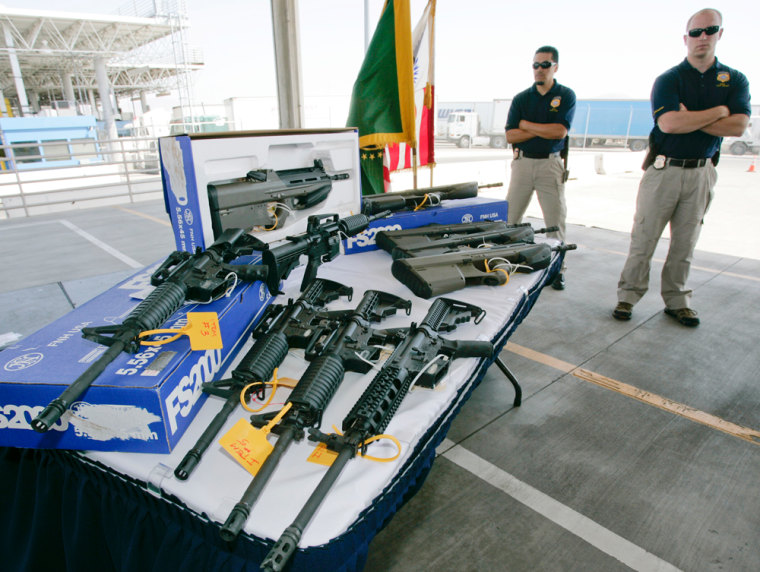The U.S. and Mexico are creating a cross-border group to develop strategies for stopping the illegal flow of guns and drugs between the two countries, officials said Thursday.
Emerging from a conference with U.S. officials, Mexican Attorney General Eduardo Medina-Mora said more meetings are needed to develop plans to bring warring drug cartels under control along the border.
Medina-Mora said Mexico planned to begin checking 10 percent of the vehicles entering the country from the U.S. for illegal weapons and will more closely check outgoing vehicles for drugs and money.
Medina-Mora said the new vehicle-inspection measures were part of Mexico's overall $1.4 billion modernization of border customs and crossing points. The first such vehicle checks are already being carried out in Matamoros, across the border from Brownsville, Texas.
Hundreds of drug-related killings
Medina-Mora also said there had about 1,600 drug-related killings in Mexico in the first quarter of 2009, about 25 percent less than the last quarter of 2008. He did not give a reason for the decline, but the government says violence has decreased in border cities like Ciudad Juarez after thousands of additional army troops were sent there earlier this year.
U.S. Homeland Security Secretary Janet Napolitano said that, in addition to beefing up border inspections north of the border, "we have to do more to reduce demand for drugs."
Napolitano and U.S. Attorney General Eric Holder met privately for several hours with Medina-Mora and Mexico's Interior Minister Fernando Gomez-Mont and Public Safety Secretary Genaro Garcia Luna.
The officials hammered out an agreement that might be signed when U.S. President Barack Obama visits Mexican President Felipe Calderon later this month.
"We want to take advantage of this moment in time," Napolitano said, referring to the elevated concern on both sides of the border about drug-related killings and kidnappings blamed on the cartels.
Medina-Mora said one point still in negotiation is how to ensure prosecution of anyone violating guns laws, whether they are arrested in Mexico or the United States. In addition, he said, the two countries will create a shared ballistics database to track weapons used in crimes.
U.S. not seeking any gun law changes
Holder said the U.S. is not seeking to change any of its gun laws as part of the effort to curb weapons smuggling.
"I don't think our Second Amendment will stand in the way of what we have begun," he said.
Except to say that "too many weapons are flowing from the United States and into Mexico," Holder did not have a number of how many guns are smuggled across the border.
The U.S. Bureau of Alcohol, Tobacco, Firearms and Explosives recently reported that up to 95 percent of guns seized at scenes of drug violence in Mexico can be traced to U.S. commercial sources.
Between 2005 and 2008, U.S. Customs and Border Protection agents seized 831 weapons along the southwest border.
Until recently, the U.S. did not regularly inspect southbound vehicles, and the Mexicans didn't scan the license plates of cars coming into the country. Facilitating legal trade, not catching gun smugglers, was the prime directive, Mexican officials said.
The threat of cartel violence is forcing a new approach. Mexico will begin scanning vehicles for drugs and money and using intelligence to target the right vehicles, Medina-Mora said.
X-ray machines and drug sniffing dogs
The U.S. will use border surveillance technology to track vehicles crossing the border and flag those making frequent trips. Additional X-ray machines and drug sniffing dogs are being deployed at border crossings to help detect weapons shipments.
Two weeks ago Customs officials at the eight railroads between the U.S. and Mexico began scanning rail cars on the way out of the U.S. instead of just on their way in. When U.S. officials see something suspicious in the X-ray, they alert Mexican law enforcement, which intercepts the rail cars in Mexico.
It was as simple as flipping a switch, said Marko Lopez Jr., chief of staff for Customs and Border Protection.
Lopez, a recent addition to the new administration, said he did not know why this wasn't being done before. "Bottom-line is that we weren't," Lopez said. "It's a huge vulnerability."
